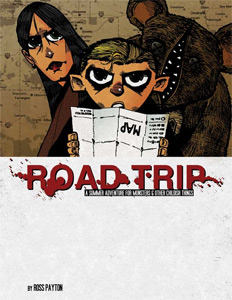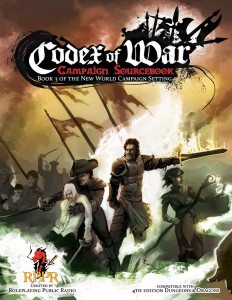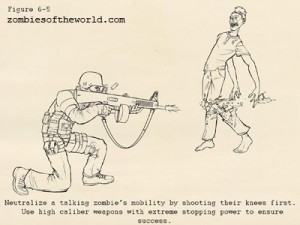Author Ross Payton has thrown together arguably the greatest field resource for would-be Zombologists to sort through all the madness that are the many variations of Walking Corpses in his new book Zombies of the World: A Field Guide to the Walking Dead!
What makes this book so different from all the other Zombie Survival/Educational Manuals out there? To put it simply: Everything! The book reads as if the author threw a Zombie Text book, A Zombie Rights Guide, A Zombie Pop-culture reference tome and a Zombie Identification guide into a massive literary blender and hit the frappe button to amalgamate them into a smooth cocktail of terror like none other!
Tag Archives: the book
Anatomy of a book: what went into Zombies of the World
 In order to create the book, I drew on the skills and resources I had gained while freelance writing in the tabletop RPG industry, running the podcast Role Playing Public Radio and designing books for Lens & Pen Press.
In order to create the book, I drew on the skills and resources I had gained while freelance writing in the tabletop RPG industry, running the podcast Role Playing Public Radio and designing books for Lens & Pen Press.
Writing: I’ve written two books for Arc Dream (Road Trip and Curriculum of Conspiracy) along with numerous shorter articles and PDFs for various companies. I’ve also written four long form PDFs for the New World Campaign, an original fantasy setting that I used for the RPPR Dungeons and Dragons campaign.
Writing for role playing games is an interesting combination of fiction and technical writing. You must write imaginative material that engages the reader yet it must described in a clear and concise manner so that it can be used in a complex game. Failing in the former task results in a boring piece that no one will want to use in their game and failing in the latter task results in rules arguments that derail the game. This style lends itself to the fictional pseudo-guide genre, as typified by books like the Zombie Survival Guide. For Zombies of the World, I went for the authoritative style common in nature guides and history texts.
Graphic Design: My background in graphic design is more limited than my writing but no less important. I’ve laid out every book published by Lens & Pen Press. While I do have some formal training in writing, my graphic design skills are entirely self-taught so I have no illusions about being a true master in this field. However, since I had developed journeyman level skills, I didn’t have to hire someone else to lay Zombies of the World out or do the prepress work so Tien Wah Press could print it. It also made it easier to write the book since I could adjust the layout to fit the content or vice versa. If a caption was a bit too long or short, it’s far easier to simply tweak it in Indesign than getting someone else to revise it.
 Collaborating over the Internet: Finding and working with artists from around the world you’ve never met face to face to create high end may sound like a daunting task if you’ve never done it before but I gained experience in doing this while working on Role Playing Public Radio. Starting in 2009, I collaborated with several artists and writers to create a series of book length PDFs for the RPPR actual play campaign, The New World. I wrote about the process of creating the first PDF, the New World Primer on my blog.
Collaborating over the Internet: Finding and working with artists from around the world you’ve never met face to face to create high end may sound like a daunting task if you’ve never done it before but I gained experience in doing this while working on Role Playing Public Radio. Starting in 2009, I collaborated with several artists and writers to create a series of book length PDFs for the RPPR actual play campaign, The New World. I wrote about the process of creating the first PDF, the New World Primer on my blog.
Through this, I met several great artists and how to contact other artists about collaborating on the Internet. Talking with them consisted mostly of emails and IMs to determine how much they could contribute, what they would contribute and other technical issues. The greatest challenge comes from communicating the ideas you want the artist to draw without confusing or alienating them. It’s also preferable, in my experience, to encourage the artist to make suggestions about the piece. They often have great ideas on improving the quality of the art. In general, I would describe the work I needed in a few paragraphs and then provide relevant background information and reference work for the artist. Then the artist would create a sketch and make suggestions and we would go back and forth until the piece had been hashed out. There’s a fine line between being too demanding and exacting and being too vague. It’s important to strike a balance between them so the artist doesn’t get burned out or confused.
With these skills, I was able to create Zombies of the World. In the next post, I’ll talk about planning and design and its importance in creating the book.
Behind the Scenes: How Zombies of the World Began
Zombies of the World first began with a single observation about zombies – they never get tired. To me, that seemed more interesting than their resurrection or predilection for human flesh. Even the few zombies that manage to catch and eat a human never seem to digest the meat and true zombies never starve. They continue to burn energy without taking in fuel. This defies the laws of thermodynamics and makes the zombie a flesh eating perpetual motion machine. With that, I began to think of how that would affect the world so I could tell my own zombie story. The genre is dominated by survivalist themed works that can be fun or even great but I wanted to do something different with them.
While zombie apocalypses are fun for storytelling and gaming purposes, they tend to follow several rules:
- Zombie populations go from 0 to infinity within hours or days. Even if they are slow, shambling zombies, civilization breaks down very quickly after the initial outbreak because there are too many zombies to count.
- Survivors of an apocalypse do not act like survivors from any other type of major disaster. For example, after the recent earthquake in Japan, even the Yakuza helped their fellow citizens out. This would never happen in a zombie apocalypse apparently though. Survivors do not cooperate, help one another or usually even act with a modicum of rationality.
- Zombies have no ancestors or history – they spawn once and wipe out civilization.
- There is little or no speciation in zombies. All zombies worldwide are of one type. There might be a few differing types, especially in video game based zombie apocalypses (Left 4 Dead and Resident Evil come to mind).
With that in mind, I wanted to break these rules so I could see how a stable society would treat the undead. So you would get:
- Zombie populations grow slowly and migration takes time. There are limited numbers of them, so it is possible to contain the undead.
- People cooperate during a zombie attack, putting aside their differences and acting rationally. They learn from their mistakes and work together to fight the undead and protect each other.
- Zombies have been present throughout history so humanity has learned how to fight them.
- The undead evolved over time and there are multitudes of species throughout the world. Varying environmental conditions favored different traits.
There have been a few stories set in worlds where humanity and zombies have learned to co-exist but they tend to be post-apocalyptic – societies that rebuild after the zombies nearly wipe everything out. By breaking all of these rules, you get a world that has had to deal with the undead for thousands of years but has learned how to deal with them.
Furthermore, wouldn’t the scientists of that world study them and try to learn how they remain animate after death? So, I pictured a world much like our own. Zombies were contained by government agencies. Some species were endangered or even extinct. Scientists and environmentalists lobbied for laws to protect the undead, because they were part of the ecosystem and needed to be studied. That is how Zombies of the World began.

